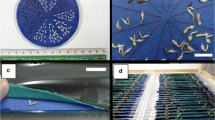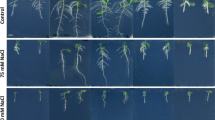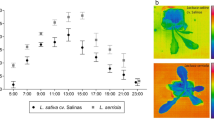Abstract
Wild plant species are often adapted to more stressful environments than their cultivated relatives. Roots are critical in exploiting soil resources that enable plants to withstand environmental stresses, but they are difficult to study. Cultivated lettuce (Lactuca sativa L.) and wild L. serriola L. differ greatly in both shoot and root characteristics. Approximately 100 F2:3 families derived from an interspecific cross were evaluated in greenhouse and field experiments. In the greenhouse, root traits (taproot length, number of laterals emerging from the taproot, and biomass) and shoot biomass were measured 4 weeks after planting. In the field, plants were grown for 9 weeks (close to harvest maturity of the cultivated parent); mild drought stress was induced by withholding water for 1 week, and gravimetric moisture of soil was then determined for five depth increments between 0–100 cm. The families were genotyped using codominantly scored AFLP markers distributed throughout the genome. Composite interval mapping was used to analyze marker-trait associations. Quantitative trait loci were identified for differences between wild and cultivated lettuce for root architectural traits and water acquisition. Thirteen QTL were detected that each accounted for 28–83% of the phenotypic variation. The loci for taproot length (i.e., cm taproot length g–1 plant biomass) and the ability to extract water from deep in the soil profile co-localized in the genome. These coincident loci were identified in separate experiments. The wild L. serriola is therefore a potential source of agriculturally important alleles to optimize resource acquisition by cultivated lettuce, thereby minimizing water and fertilizer inputs and ultimately enhancing water quality.
Similar content being viewed by others
Author information
Authors and Affiliations
Additional information
Received: 25 February 2000 / Accepted: 31 March 2000
Rights and permissions
About this article
Cite this article
Johnson, W., Jackson, L., Ochoa, O. et al. Lettuce, a shallow-rooted crop, and Lactuca serriola, its wild progenitor, differ at QTL determining root architecture and deep soil water exploitation. Theor Appl Genet 101, 1066–1073 (2000). https://doi.org/10.1007/s001220051581
Issue Date:
DOI: https://doi.org/10.1007/s001220051581




